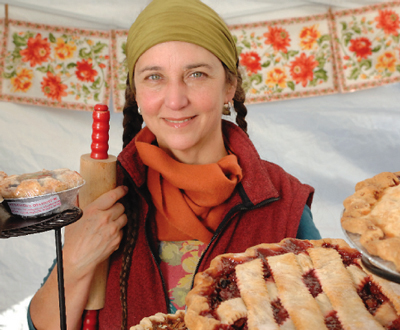Maria Craft-Neto sells memories. Nicol Irvin organizes memorable occasions. Craft-Neto has been in business 19 years, baking pies that remind her customers of lazy summer days or happy holiday gatherings. Irvin’s event-planning company is only a few years old, but its client list ranges from Stanford University to Wired magazine. Neither ended up where she is by choice. Craft-Neto had a family to feed and a baking partnership that went bust. Irvin was laid off from a corporate marketing job. They needed help— one to keep a young business alive, the other to make a longtime dream into a reality. That’s when they turned to Women’s Initiative, a 20-year-old program that teaches low-income women entrepreneurship and business skills.
Women’s Initiative expanded to Marin last year following increased attendance by Marin women at its Oakland and San Francisco classes. Organization CEO Julie Castro Abrams, of Novato expects 1,000 women to attend the 10-week series of classes, held in Terra Linda, in the first five years. Still, she says, that’s not enough: “if we could serve 500 women (this) year, we’d probably be starting to just scratch the surface.” Marin’s first graduates made plans to launch restaurants, photo studios, child care centers, cleaning services and clothing boutiques.
Perhaps it’s surprising that here in one of the nation’s most affluent counties, such a service meets a demand. But the numbers show a need. Women’s Initiative says 22 percent of local households live below the self-sufficiency level of about $63,000 annually for a family of three.
Maria Craft-Neto fits the profile. She had been working in several restaurants part time to help make ends meet for her family, a husband and two children. In 1989, she put $10,000 into a bakery business with several partners. When the partnership fizzled, she focused on pies but knew she had to raise her business acumen to match her baking abilities. She enrolled in a Women’s Initiative program in San Francisco.
“It was just perfect timing in that I needed to have that business savvy and support,” said Craft-Neto. Today, her business, Delicieux Fine Desserts in San Rafael, is doing well. She has three employees and sells, among other places, directly from local farmers’ markets. Buyers pay up to $25 for Craft-Neto’s pies (strawberry rhubarb is a favorite). And for that they get more than dessert: they also get those memories. “Nothing can transport you back in time like a good pie,” she notes.
When Irvin found herself out of work in 2005, she had an MBA and years of corporate experience. But she had never owned a business and wanted more “tools in my toolbox” to make it happen. “The universe finally forced my hand,” she says.
At first Irvin was skeptical about Women’s Initiative. Would the classes really help someone with her experience? But after she signed up and started making the twice-a-week trip to Oakland, she realized there was much to learn—setting a pricing structure, conducting market research, identifying ideal clients and other core business practices.
“The program teaches not just the tangible items like figuring out the break-even point,” says Irvin, “but also how to build confidence that allows you to say to people, ‘This is how much it’s going to cost, this is how I see it unfolding.’ It teaches you how to be really comfortable in your own skin when it comes to being a businesswoman.”
Irvin launched her Sausalito company, Signature Events, while still attending classes. Within months, she was handling several major events, including a 1,000-person dinner.
Women’s Initiative has a simple goal: give women tools to build economic independence for themselves and their families. Students must meet only two requirements —have a business idea and a low income (less than about $51,000 for a family of three). Those who’ve completed the program now own catering companies, auto repair shops, web design firms and hair salons.
Student fees never top $100 and are subsidized. The program costs about $1,450 per student, with foundations, donors and government agencies contributing to the organization’s $3.7 million budget to make up the difference.
The results are impressive. Women’s Initiative says the average annual income of new participants is $14,000; two years after training, it leaps to more than $37,000. Of program alums, 70 percent have their own business within two years. The ripple effect from such success is wide: Women’s Initiative generates $23 for the local economy for every $1 invested in the program, Abrams says.
With the opening of Women’s Initiative in Marin, Abrams believes, there will be many more success stories like Craft-Neto’s and Irvin’s to tell. “In Marin,” she says, “we’ve got independent shops as well as lots of family-run businesses. What we’re looking to do is give qualified Marin women a helping hand, in order to become a thriving part of our community’s economy while at the same time financially taking care of themselves and their families.”
Women’s Initiative Client Profile
Average age is 41
78 percent are women of color
46 percent speak Spanish as their first or only language
29 percent are single parents
15 percent have a disability


